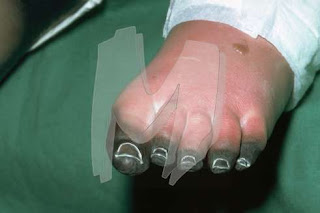[Extracted from the web page of www.hubpages.com]
The pumpkin, a member of the Cucurbita family including squash and cucumbers, got its name from the Greek word "pepon" for large melon. Seeds (pepitas) from related plants have been found in Mexico, dating back over 7000 years to 5500 B.C.
*
Natives uses for pumpkins, isqoutm, or isquotersquash as they were called, varied from function to healing. Not only did they flatten and dry thin strips of pumpkin, making them into mats, but research shows, many Native American tribes were well aware of the pumpkin's healing properties.
Nutritional Value of Pumpkin
*
Given below is the amount of nutrients present in 1 cup Pumpkin (cooked, boiled and drained) :
- Calcium - 37 mg
- Carbohydrate - 12 gm
- Dietary Fiber - 3 gm
- Folate - 21 mcg
- Iron - 1.4 mg
- Magnesium - 22 mg
- Niacin - 1 mg
- Potassium - 564 mg
- Protein - 2 grams
- Selenium - 0.50 mg
- Vitamin A - 2650 IU
- Vitamin C - 12 mg
- Vitamin E - 3 mg
- Zinc - 1 mg
- Calories - 49
Antioxidant Rich
*
Beta carotene---The rich orange color is a dead give away to the nutrients present in pumpkin. Research shows that people who eat a diet rich in beta-carotene are less likely to develop certain cancers than those who fail to include beta-carotene-rich foods in their diet.
*
Loaded with Potassium---Studies show people who have a potassium rich diet lower the risk for hypertension. Potassium rich foods include bananas, broccoli, avocados, pomegranate and many others.
*
Zinc---Not only is zinc a major boost for your immune system, it also aids in bone density support for people at risk for osteoporosis.
*
High in Fiber---Diets rich in fiber may prevent cancer, heart disease and other serious ailments.
Health & Nutrition Benefits of Eating Pumpkin
- Pumpkin is very rich in carotenoids, which is known for keeping the immune system of an individual strong and healthy.
- Beta-carotene, found in pumpkin, is a powerful antioxidant as well as an anti-inflammatory agent. It helps prevent build up of cholesterol on the arterial walls, thus reducing chances of strokes.
- Being rich in alpha-carotene, pumpkin is believed to slow the process of aging and also prevent cataract formation.
- Pumpkins have been known to reduce the risk of macular degeneration, a serious eye problem than usually results in blindness.
- The high amount of fiber, present in a pumpkin, is good for the bowel health of an individual.
- Being loaded with potassium, pumpkin is associated with lowering the risk of hypertension.
- The presence of zinc in pumpkins boosts the immune system and also improves the bone density.
Health & Nutrition Benefits of Pumpkin Seeds
- They promote overall prostate health, apart from alleviating the problem of difficult urination that is associated with an enlarged prostate.
- They comprise of L-tryptophan, a compound that has been found to be effective against depression.
- They are believed to serve as a natural protector against osteoporosis.
- They have been known to reduce inflammation, without causing the side effects of anti-inflammatory drugs.
- Studies have revealed that they help prevent calcium oxalate kidney stone formation.
- Being rich in phytosterols, they have been associated with reducing the levels of LDL cholesterol.
===================================
For your information
When you enjoy a big bowl of fresh pumpkin, you don’t have to feel guilty. A full cup of pumpkin cut into cubes has only thirty delicious calories and almost no fat. This makes it a naturally sweet and tasty treat if you happen to be watching your calorie intake. In fact, pumpkin can be a good substitute for higher calorie desserts when served warm with a sprinkling of cinnamon and a little sugar-free pancake syrup. Of course, if you turn it into pumpkin pie, you’ll boost the calories unless you use low fat, sugar-free ingredients. Even standard pumpkin pie is lower in calories than most pies and desserts.
*
Have you ever wondered what gives pumpkin its brilliant orange color ? The credit can be given to the beta-carotenes which are found in such abundance in this fruit. Beta-carotenes are antioxidants which are converted to vitamin A in the body. They are thought to boost the immune system and help to repair free radical damage to cells. Beta-carotenes are being studied to determine what role they play in the prevention of various disease states. These healthy, bright orange pigments are also found in carrots. This is one reason your mom always pushed you to eat your carrots. She would have wanted you to eat pumpkin too.
*
Pumpkin is also a rich source of vitamin C and potassium which may help to prevent heart disease and normalize blood pressure.
It’s not just the pumpkin meat itself that has health benefits. The part that many people discard, the pumpkin seed, also has health benefits of its own. A study carried out in Budapest, Hungary showed that patients with benign enlarged prostate (BPH) who were treated with pumpkin seed oil extract had a stronger urine flow and a reduction in the frequency of nighttime urination. It’s thought that pumpkin seed oil may help to prevent prostate enlargement by blocking testosterone, the male hormone that can trigger prostate growth.
*
Now that you know the health benefits of pumpkin, it’s time to add some to your diet. Look for them next time you’re at your grocery store or buy them at your local farmer’s market.




















































